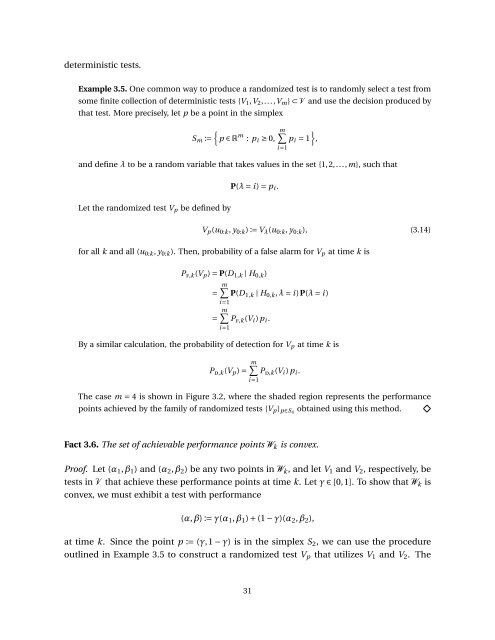Probabilistic Performance Analysis of Fault Diagnosis Schemes
Probabilistic Performance Analysis of Fault Diagnosis Schemes
Probabilistic Performance Analysis of Fault Diagnosis Schemes
Create successful ePaper yourself
Turn your PDF publications into a flip-book with our unique Google optimized e-Paper software.
deterministic tests.<br />
Example 3.5. One common way to produce a randomized test is to randomly select a test from<br />
some finite collection <strong>of</strong> deterministic tests {V 1 ,V 2 ,...,V m } ⊂ V and use the decision produced by<br />
that test. More precisely, let p be a point in the simplex<br />
{<br />
S m := p ∈ R m : p i ≥ 0,<br />
m∑<br />
i=1<br />
}<br />
p i = 1 ,<br />
and define λ to be a random variable that takes values in the set {1,2,...,m}, such that<br />
Let the randomized test V p be defined by<br />
P(λ = i ) = p i .<br />
V p (u 0:k , y 0:k ) := V λ (u 0:k , y 0:k ), (3.14)<br />
for all k and all (u 0:k , y 0:k ). Then, probability <strong>of</strong> a false alarm for V p at time k is<br />
P f,k (V p ) = P(D 1,k | H 0,k )<br />
m∑<br />
= P(D 1,k | H 0,k ,λ = i ) P(λ = i )<br />
=<br />
i=1<br />
m∑<br />
P f,k (V i ) p i .<br />
By a similar calculation, the probability <strong>of</strong> detection for V p at time k is<br />
i=1<br />
P d,k (V p ) =<br />
m∑<br />
P d,k (V i ) p i .<br />
i=1<br />
The case m = 4 is shown in Figure 3.2, where the shaded region represents the performance<br />
points achieved by the family <strong>of</strong> randomized tests {V p } p∈S4 obtained using this method.<br />
Fact 3.6. The set <strong>of</strong> achievable performance points W k is convex.<br />
Pro<strong>of</strong>. Let (α 1 ,β 1 ) and (α 2 ,β 2 ) be any two points in W k , and let V 1 and V 2 , respectively, be<br />
tests in V that achieve these performance points at time k. Let γ ∈ [0,1]. To show that W k is<br />
convex, we must exhibit a test with performance<br />
(α,β) := γ(α 1 ,β 1 ) + (1 − γ)(α 2 ,β 2 ),<br />
at time k. Since the point p := (γ,1 − γ) is in the simplex S 2 , we can use the procedure<br />
outlined in Example 3.5 to construct a randomized test V p that utilizes V 1 and V 2 . The<br />
31













